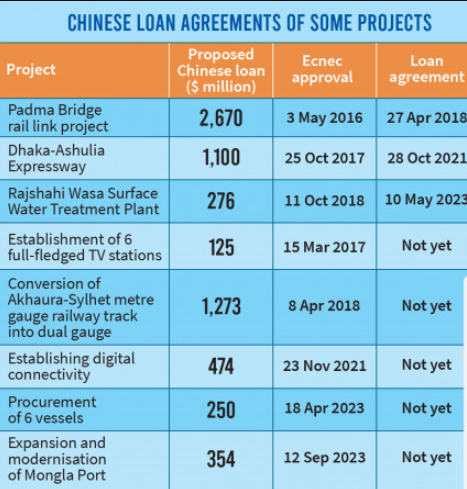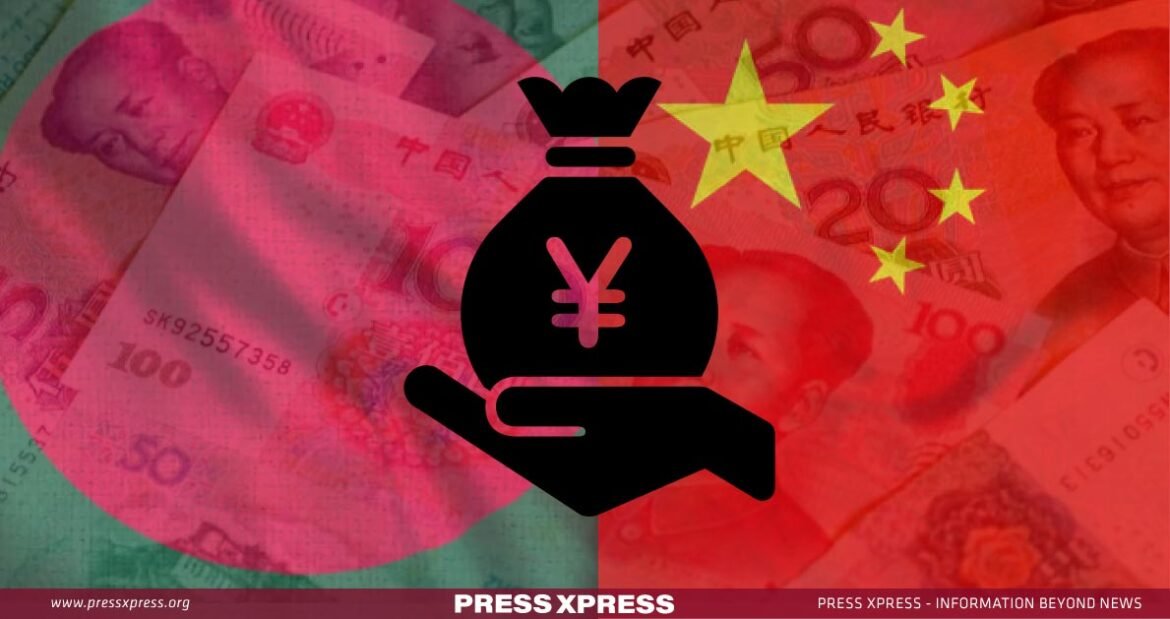Bangladesh is planning to request over 36 billion yuan ($5 billion) in soft loans from China to alleviate pressure on its dwindling dollar reserves. Government sources indicate the funds will support businesses importing raw materials and provide budget assistance.
China is Bangladesh’s largest trading partner, with Bangladesh exporting $677 million worth of goods to China and importing $22.9 billion in fiscal 2022-23 according to commerce ministry data.
You Can Also Read: CHINA AND BANGLADESH STRENGTHEN MILITARY TIES WITH JOINT EXERCISES
Media reports citing concerned government officials said the Prime Minister’s Office has greenlit the loan proposal. Officials are now discussing interest rates, repayment periods, and how the money will be allocated. They are aiming for long-term loans with interest rates below 1%.
A key purpose is to ease the strain on Bangladesh’s reserves, which stood at $19.95 billion as of April 30th. The government wants to aid businesses impacted by the Bangladesh Bank’s reduction of the Export Development Fund for importing raw materials.
During negotiations, Bangladesh will seek flexible terms allowing the funds to facilitate trade beyond just China. Interest rates and repayment schedules will be finalized then, per a top commerce ministry official.
The loan was broached during bilateral talks between the Bangladeshi and Chinese commerce ministers at a WTO conference in February-March. The Chinese minister responded positively when officially approached afterward by Bangladesh. In September 2022, the Bangladesh Bank allowed the settlement of international trade in the Chinese yuan to cut excessive dependence on the dollar.

China Now 4th Largest Source of Foreign Loans in Bangladesh
China has emerged as the fourth largest source of foreign loans for Bangladesh, driven by the latter’s increasing interest. Japan, the World Bank, and the Asian Development Bank (ADB) now rank ahead of China in terms of loan disbursements to Bangladesh.
Currently, China accounts for nearly 10% of Bangladesh’s total annual borrowings, with at least $1 billion disbursed annually over the past two years. Bangladesh has witnessed a surge in Chinese loans since 2016 when President Xi Jinping made a state visit to Dhaka. China has disbursed nearly $3 billion over the last four fiscal years, accounting for around 40% of its total lending to Bangladesh to date.
However, there has been an unusual spike in Chinese loan disbursements to Bangladesh over the past four years, with the amount nearly doubling during this period.
According to the Economic Relations Division (ERD), China disbursed $600 million in loans in fiscal year 2019-20, which then plunged to $240 million the following fiscal year. But disbursements rebounded sharply, with Bangladesh receiving $1.004 billion in Chinese loans in fiscal 2021-22, rising further to $1.126 billion the next year.
Thus, China is gradually solidifying its position as a major lender to Bangladesh. It now ranks second among bilateral lenders to the country after Japan.

In the last fiscal year, the World Bank provided the highest amount at $1.93 billion in loans to Bangladesh, followed by Japan at $1.9 billion, the ADB at $1.56 billion, and China securing the fourth spot with $1.12 billion in lending.
Overall, Bangladesh received $9.26 billion in total from various lenders in the last fiscal year.
Type And Cost of Chinese Loans
The Chinese government typically extends two types of loans to other countries: Preferential Buyer’s Credit (PBC) denominated in US dollars, and Government Concessional Loan (GCL) denominated in its own currency, the Chinese yuan. Both of these loan types carry an interest rate of 2%, which is comparable to the rates offered by major multilateral lenders like the World Bank (WB) and the Asian Development Bank (ADB). Additionally, the Chinese loans include a commitment fee of 0.25%.
In comparison, loans from the International Development Association (IDA), which is the concessional lending arm of the World Bank Group, feature a lower interest rate of 1.25%, along with a service charge of 0.75%. Japanese bilateral loans, on the other hand, have the most favorable terms with an interest rate of just 1.6%, making them the lowest-cost option among major lenders.
It’s worth noting that some of the World Bank’s loans are based on market interest rates, which currently exceed 5%. However, these loans typically offer a longer repayment period, usually ranging from 30 to 40 years, providing more time for the borrowing country to repay the loan.
Similarly, over two-thirds of the loans extended by the Asian Development Bank are linked to market-based interest rates, which can be higher than the fixed rates offered by other lenders.
One potential drawback of Chinese loans is their relatively shorter repayment period. Excluding the grace period, the entire repayment period for Chinese loans usually ranges from 10 to 15 years. This shorter repayment timeline ultimately leads to higher installment amounts and increases the overall repayment pressure on the borrowing country.
While the interest rates on Chinese loans are competitive with those offered by major multilateral lenders, the shorter repayment periods can pose a challenge for some borrowing countries, particularly those with limited fiscal space or economic vulnerabilities. Careful consideration of the repayment terms and the overall debt sustainability is crucial when taking on Chinese loans or any other external borrowing
Chinese Loan Status in Bangladesh
Bangladesh has received 17 billion yuan (equivalent to $2.5 billion) in yuan loans, of which 3.2 billion yuan has been repaid in principal and interest, according to data from the finance ministry.

Bangladesh currently has 10 projects in the pipeline with Chinese financing. Of these, Bangladesh has already agreed to receive 9.49 billion yuan (equivalent to $1.32 billion) in yuan for six projects. China has now proposed to provide $2.87 billion (equivalent to 20.65 billion yuan) in yuan for the remaining four projects. If Bangladesh accepts these loans in yuan, its total debt in the Chinese currency will amount to 45.84 billion yuan.
The China Opportunity
More than a decade ago, during the formulation of Bangladesh’s sixth five-year plan, the country foresaw a ‘once-in-a-lifetime window of opportunity’ to capitalize on China’s rapidly eroding competitive advantage and increase exports of labor-intensive products. This was a path that several Southeast Asian nations were also exploring at the time. A section of the sixth five-year plan, titled ‘The China Opportunity’, highlighted those countries like Bangladesh, Vietnam, Cambodia, Indonesia, the Philippines, and even India that were poised to benefit from China’s declining competitiveness in labor-intensive manufacturing sectors.
The plan posed a thought-provoking question: “Investors are scurrying for the next best location for manufacturing clothing, shoes, toys, and other labor-intensive products. Why not Bangladesh?” It expressed the hope that during the sixth plan period, Bangladesh would position itself comprehensively – with supportive incentive schemes, investment incentives, and a liberal import regime – to secure a solid foothold as one of Asia’s export hubs.
The plan forecasted, “In terms of attractive trade and investment policies, Bangladesh will match countries like Vietnam and Indonesia, which are vying to take a bigger chunk of the Chinese pie that is up for grabs.” However, this anticipated outcome has not materialized to the desired extent.
While Bangladesh has attracted a few export orders that have shifted from China, the amount remains negligible in comparison to the anticipated ‘China Opportunity’. China’s share of global ready-made garment (RMG) exports has declined from 39% to approximately 30%, but Bangladeshi exporters have managed to secure only a small portion of this market.
The current five-year plan (2020-2025) draws inspiration from China’s post-1978 development strategy, which fueled its remarkable ascent through export growth, rapid economic expansion, and poverty reduction, driven by pragmatic market-oriented reforms. The plan underscores China’s extensive investments in domestic market integration, enhancing connectivity through road and coastal infrastructure development.
China’s approach to connectivity aligns with its global blueprint, the Belt and Road Initiative (BRI), designed to foster closer global connections via road, rail, sea, and air. Bangladesh’s substantial connectivity projects, such as the Padma rail bridge, Bangabandhu Tunnel, and Chattogram-Cox’s Bazar rail link, mirror China’s regional integration efforts.
Nevertheless, Bangladesh’s geographical location does not facilitate the same level of integration with China as some of its Asian neighbors, like Malaysia, Singapore, and the Philippines, which enjoy robust trade and investment ties with the Chinese economy.
Since China and Bangladesh formally established diplomatic relations on October 4, 1975, the friendly bilateral relations between the two countries have been developing in a sound and stable manner over the past years.
Several major infrastructure projects have been implemented by Chinese enterprises in the fields of transportation, energy, power, and communications in Bangladesh, making positive contributions to the economic and social development of the two countries.


